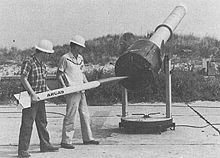Arcas (rocket)
The Arcas was a single-stage US sounding rocket that was mainly used for weather measurements. The name stands for "All-purpose Rocket for Collecting Atmospheric Soundings , where the first three letters are also the abbreviation for the manufacturer Atlantic Research Corporation .
development
In early 1957, the Stanford Research Institute showed in a study that a small single-stage rocket would be useful for measuring wind conditions at altitudes of around 45 km. This was primarily necessary to estimate the fallout after nuclear tests, but was also intended to serve civil weather measurements. The Office of Naval Research (ONR) and the Air Force Cambridge Research Center (AFCRC) awarded the development contract to the Atlantic Research Corporation in January 1958 . The first test flights of the Arcas took place at the end of 1958, and the rocket was used regularly from 1959.
construction
The Arcas was 2.30 m long and had a fin span of 0.33 m with a diameter of eleven centimeters. She had a launch mass of 34 kilograms. The take-off thrust was relatively low at 1.5 kN so that the sensitive payload was not exposed to unnecessarily high loads. The burn time was 29 seconds, which means that, depending on the starting angle, a summit height of approx. 60 kilometers was reached.
The first Arcas version was called PWN-6A Kitty and was equipped with a measuring probe of the type AN / DMQ-6, which was deployed at the apex of the track. While the probe sank down on the parachute, it transmitted air pressure and temperature by radio. At the same time, the probe was tracked by radar. The wind speed and direction at different heights could be calculated from the data obtained. The successor version PWN-6B had an additional transponder. The PWN-7 Robin version had a balloon with a metal shell instead of a parachute probe, which was released and inflated at the apex.
Starting device
The Arcas was launched from a cannon-like device. Since the rocket had no controls, the device had to be aligned in azimuth and elevation before launch, with cross winds also being taken into account. Only two people were required to prepare for the launch.
commitment
The Arcas was produced in large numbers in the 1960s. About 6000 launches were made in the first ten years. The start was not only from various American locations, but also from McMurdo Station (Antarctica), Antigua Air Station ( Antigua and Barbuda ), Ascension , CELPA , Mar Chiquita and Tartagal (Argentina), Barbados , and Kindley Air as part of international collaborations Force Base ( Bermuda ), Natal (Brazil), Thule (Greenland), Thumba (India), Fort Churchill and Primrose Lake (Canada), Birdling's Flat (New Zealand), Fort Sherman ( Panama Canal Zone ), Kronogård (Sweden) and Grand Turk Iceland (Turks and Caicos Islands). At the end of the 1960s, the Arcas was replaced by the cheaper Loki Dart .
See also
Web links
- Arcas in the Encyclopedia Astronautica (English)
Individual evidence
- ↑ Helen T. Wells, Susan H. Whiteley, Carrie E. Karegeannes: Sounding Rockets. In: SP-4402 Origins of NASA Names. NASA, 1976, p. 125 , accessed February 4, 2018 .
- ^ A b c Andreas Parsch: Atlantic Research PWN-6 Kitty. In: Directory of US Military Rockets and Missiles. December 22, 2005, accessed February 4, 2018 .
- ^ A b c d Smithsonian National Air and Space Museum: Rocket, Sounding, Arcas. Accessed February 4, 2018 .
- ^ Andreas Parsch: Atlantic Research PWN-7 Rooster. In: Directory of US Military Rockets and Missiles. December 22, 2005, accessed February 5, 2018 .
- ^ Air Force Space and Missile Museum: Arcas Launcher. Accessed February 4, 2018 .
- ↑ Arcas in the Encyclopedia Astronautica , accessed on February 4, 2018.
